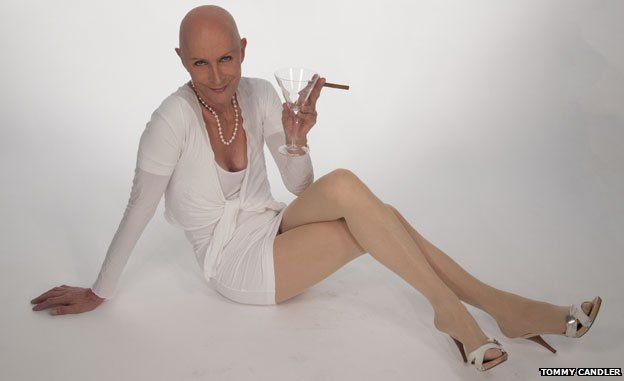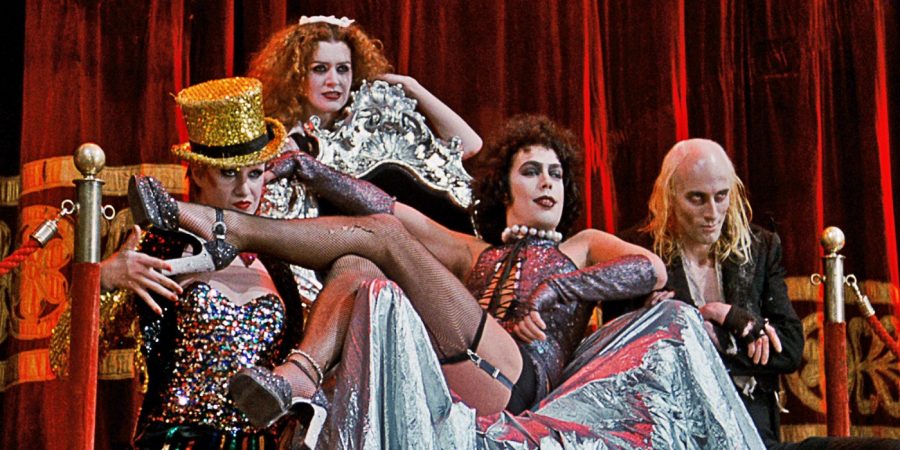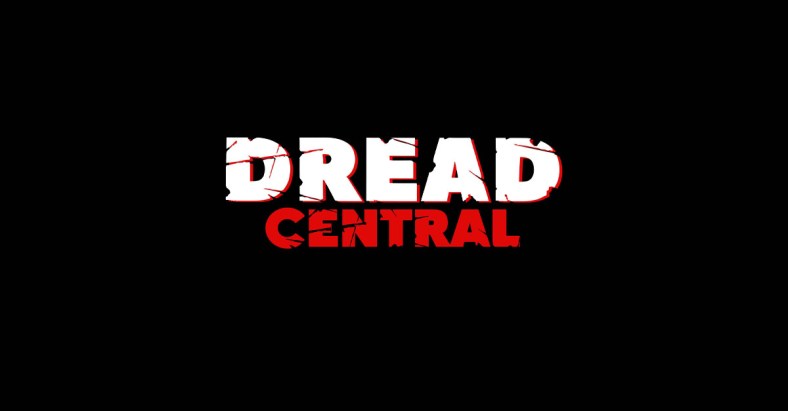The Rocky Horror Picture Show (1975) is a musical comedy horror (a genre that also encompasses the beloved Little Shop of Horrors (1986)) directed by Jim Sharman and written by Richard O’Brien. It stars Tim Curry Queer, Susan Sarandon, and Barry Bostwick with supporting roles by Richard O’Brien, Patricia Quinn, and Nell Campbell.
It follows two squeaky clean mid-century stereotypes, Brad and Janet, who get a flat tire in a rainy forest and are forced to seek help in a nearby castle – a castle that happens to contain a race of sexually liberated, gender-questioning aliens that are more than happy to welcome the duo.
It devolves into cheesy sci-fi horror that involves a sexy Frankenstein’s monster named Rocky and a freeze ray but also deep social issues like questioning your sexuality, gender, and lifestyle.
You can expect:
- Outstanding music
- Amazing dancing
- Dazzling costumes
- An amazing sci-fi B movie feel (like you’re at a drive-in theatre)
And yummy vocals and acting from the legendary Tim Curry as Frank-N-Furter. Not to mention not often heard singing from Susan Sarandon, who sports an outstanding, spine-tingling mezzo-soprano voice.
A Brief Note on Rocky Horror’s Creator, Richard O’Brien

So let’s address the LGBTQ+ representation and visibility of the queer community in the film. Can something made over 40 years ago even have good representation?
The short answer is yes. When the writer himself, Richard O’Brien, is non-binary, describing himself as “70% male and 30% female”, it goes to figure that it would still be relevant, even if it was written decades ago.
The long answer will be the rest of this article.
ROCKY HORROR PICTURE SHOW CONTROVERSY
O’Brien himself has said some very controversial things regarding trans women that he has since taken back and apologized for, spoke of in this article. His thoughts and opinions are hard to pin down, as the stunning Laverne Cox had the starring role in the remake The Rocky Horror Picture Show: Let’s Do The Time Warp Again (2016).
This writer personally believes his harsh words stem from internalized transphobia and frustration with his own lifelong struggles with gender identity.
But you aren’t here for my opinion on Richard O’Brien. You’re here for my opinion on his amazing creation.
Frank-N-Furter: A Villain CAN Be Decent Representation

The first time I watched this film I got literal chills when I watched the “Sweet Transvestite” musical number. When it concluded, I realized I was literally sitting there with an open mouth. It not only portrays a loud, proud Frank-N-Furter who is shown to be stunning and attractive to both Janet and Brad, but it also quite clearly depicts the polycule relationship between Frank, Magenta, Riff Raff, and Columbia.
For anyone who doesn’t know: Polycule – a connected network of people in a non-monogamous relationship. Used by the polyamory community.
This scene shook me and affirmed that I was a gay man long before I ever came out.
What follows is Brad and Janet being forced to stay the night as their flat tire can’t be fixed, so they’re both set up with a guest room. A guest room that Frank-N-Furter lecherously invades in the night. He shows up in Janet’s room to seduce her with his charm and wiles, kissing her neck and telling her that he could be so much better than Brad until she eventually gives in and throws herself at him.
What follows is…an identical scene with Brad.
Frank-N-Furter seduces and charms Brad, kisses his neck, and tells him he could be so much better than Janet for him. Until Brad eventually gives in and throws himself at him.
For a film made in the 1970s, this blew me away.
It displays Frank-N-Furter’s charisma across all people in an exactly paralleled scene. His ability to charm and persuade. It’s obviously a bit obscene and scummy – but it’s also sexy, fun, and portrayed in a lighthearted, humorous way.
Is Frank-N-Furter a questionable character to be representing the queer community? Well yes, because he is a villain. But it’s in the way he’s portrayed that’s different. He’s fun. He’s funny. He’s sexy. And –
Spoiler alert for the end of the movie.
And at the end when he’s betrayed by Riff Raff and shot – you feel actual remorse. Columbia and Rocky both weep. Brad and Janet are saddened. He isn’t just another queer-coded villain included for morality’s sake and has a gruesome end for his heinous lifestyle.
That last bit was said in a deep, menacing voice. Just so you know.
The Queer Community and Sexual Liberation Flourished in the ’70s

The film isn’t just Frank-N-Furter stabbing a high heel into heteronormative society and loudly shouting that the queer community is here to stay. It has a lot more to say. The Rocky Horror Picture Show delves into topics like self-discovery and self-actualization with the sappy lead characters, Brad and Janet.
Brad ends up confused in the typical mid-century male role that he’d never questioned before when suddenly he feels feelings for another man and feels beautiful dressing in stockings and wearing makeup. It’s scary, it’s new, yet he loves it.
Janet similarly is shown something other than the role of a doting, devoted housewife – the love of sex, liberation in her own sexuality, and loving her body. Exploration and independence in relationships was something that nobody was encouraged to do then – most especially women.
The Rocky Horror Picture Show isn’t just a celebration of the queer community – it’s anti-slut-shaming.
By openly displaying sex, sexual humor, and LGBTQ+ representation, The Rocky Horror Picture Show sent a surge of liberation through the 1970s. We were fresh off the Stonewall Riots, Tom of Finland was publishing gay comic books, and the queer community was becoming louder by the hour. As mentioned in this article, LGBTQ+ individuals were more comfortable in the 1970s than they were in the ‘80s or ‘90s, because of the AIDS epidemic.
The 1970s was the quintessential queer renaissance.
A shock wave of sexual liberation and gay pride was sent out in 1975 with its initial release and continues to reverberate, inspiring LGBTQ+ people to this day, including the writer of this article.
Rocky Horror Addresses That Discovery Is Only The First Step

The Rocky Horror Picture Show not only supported queer individuals who were closeted or harassed. It made people question their identity, orientation, and lifestyles when they never had before. You could slip yourself into Brad’s shoes and be someone who thought they had it all figured out – uncomplicated. But then you’re presented with a life that feels good, looks good, and brings you such satisfaction.
It’s complicated, sure. It’s almost terrifying. But what if you never knew in the first place?
The very end of The Rocky Horror Picture Show touches on this (the UK version, as the US version cut the ending) as Brad and Janet crawl from the wreckage of the house. They both sing one final verse in the song “Superheroes” that amounts to confusion with their new identities and sexualities – but they can’t go back to their other lives and forget what happened here.
It’s no wonder it inspired a generation as it portrays a queer journey step-by-step:
- Discovery
- Shock
- Questioning
- Identifying and relating
- Embracing the culture
- Fear of the unknown
- Knowing there’s no going back
Disclaimer: This isn’t everyone’s queer journey, although it closely mimics mine.
The Rocky Horror Picture Show has an absolutely shocking theme and portrayal for a 1970’s film that is far ahead of its time. I’m sure a lot of people write it off immediately due to its tacky sci-fi plot. And I’ve heard people in my LGBTQ+ circle mention the “Sweet Transvestite from Transsexual Transylvania” line sounding offensive or triggering.
But I assure you, as a loud, proud queer myself, this film has done nothing but inspire me, drive me, and make me question my identity until I was pleased with it.
I couldn’t recommend this film more and many of our LGBTQ+ forefathers, foremothers, and foreparents agree with me. The Rocky Horror Picture Show has cemented itself in the queer community and culture and it’s definitely here to stay.
Excuse me. I need to go find my black high heels.
Hungry for more queer representation and inspiration? Check out Trans Representation Through Disney’s Mulan and Wolfwalkers Deserves More Acclaim Than Luca For Pride Awareness Through A Metaphor.

Leave a Reply